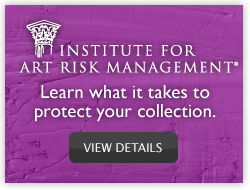The majority of art thefts today are not the sensational, highly publicized thefts from museums or galleries, but are thefts from private residences and estates that are usually less than adequately protected. A review of many of these thefts shows that many could have easily been prevented had adequate physical, technical and operational security applications been implemented.
In order to develop an effective art risk management plan, the first step is to assess the risk exposure of the collection. This includes a thorough understanding and analysis of the artwork in the collection, the environment in which it exists, the client’s needs in terms of displaying, exhibiting, storing or investing in artwork, as well as what planning currently exists to manage the risk, regardless whether it is an individual collection, gallery or museum.
Two often overlooked aspects of managing risk for art collections are insurance coverage and estate planning. The results of inadequately insuring art that is stolen and not recovered is fairly obvious, yet owners many times fail to recognize that the cost for insurance is usually affordable in contrast to the value lost as a result of a theft. Estate planning can be much more complex considering issues of value, cultural heritage, the adequacy of provenance and past due diligence efforts as they may affect challenges of ownership or title to heirs.
The Annapolis Group can work with the client to prioritize these assets, analyze the overall environment by assessing all elements of potential threat and vulnerability, and develop a plan that, based on the client’s acceptable level or risk, mitigates or eliminates the various aspects of risk.
This service includes the following:
- Identifying Physical & Technical Security Requirements for State-of-the-Art Technology Solutions
- Review of Existing Cataloging and Record Keeping
- Review of Existing Environmental Conditions
- Review of Insurance & Estate Planning
The results of the analysis is documented in a detailed risk management plan that includes all findings as well as recommendations for obviating or eliminating identified risks and vulnerabilities.
Contact us today for a Complimentary Consultation.



